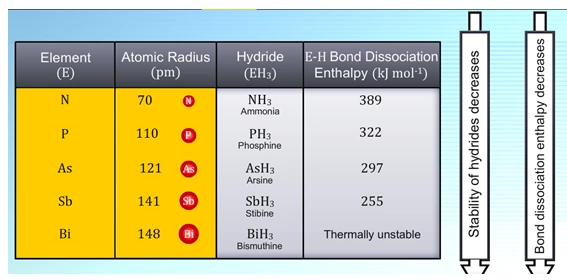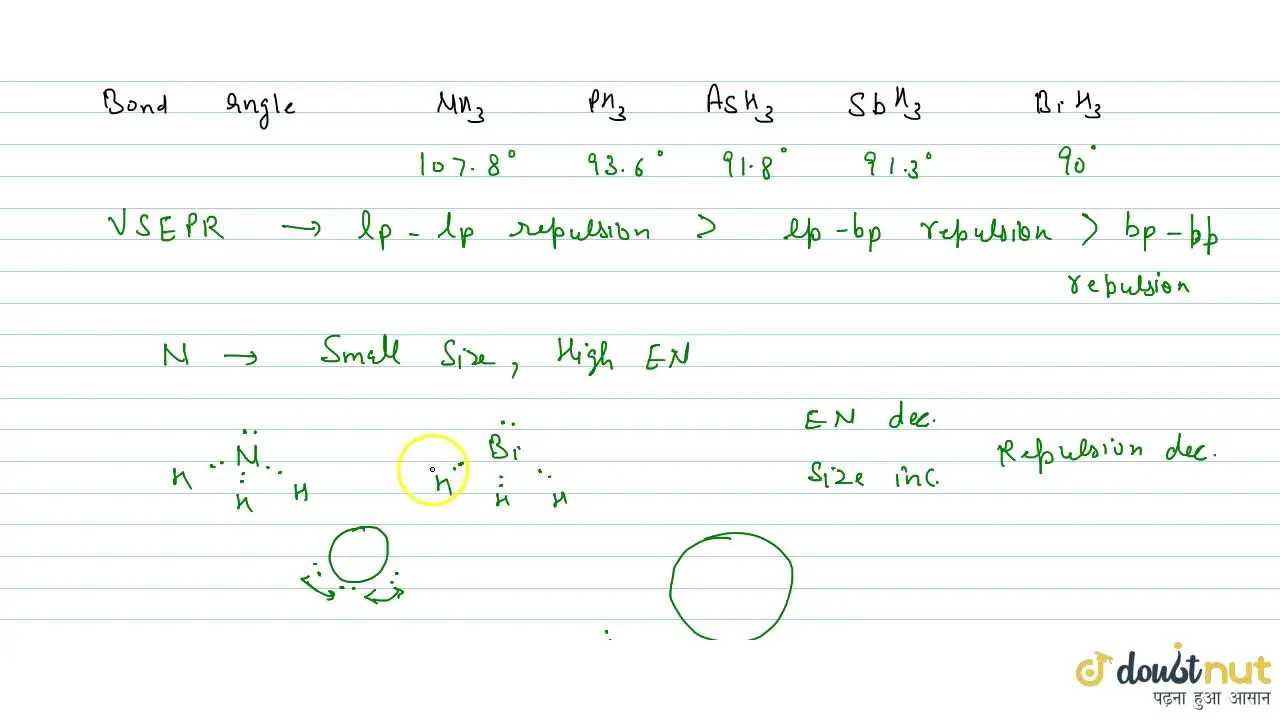Reaction With Water
Reaction with Water with Group 15 (VA) Elements
Group 15 is comprised of nitrogen, phosphorous, arsenic, antimony, and bismuth. Elements in Group 15 have five electrons in valnce shell. Because the elements can either increase three electrons or lose five to attain a stable electronic configuration, they typically form covalent compounds unless bonded to an active metal. Their electron affinities are not huge. Metallic properties increase extraordinarily from gaseous nitrogen to scarcely metallic bismuth with increasing size and mass. Antimony ansd arsenic and are metalloids, and phosphorus and nitrogen are non-metallic.
Elements of this group are referred to as pnicogens and their compounds as pniconides. The name is gotten from the Greek word pnicomigs meaning suffocation.
These elements are significantly less reactive than the elements of Group 16, and their chemical characteristics and reactions are more complex. Most of the chemical reactions of these elements are in the +3 or +5 oxidation states, in spite of the fact that they form gaseous compounds with hydrogen in the - 3 oxidation state: alkali NH3, phosphine PH3, arsine AsH3, stibine , and bismuthine BiH3; these all consume in oxygen to yield oxides or the free component (on account of nitrogen).
All form oxides—nitrogen with trouble, the others easily. Most of the oxides are acidic, exceptions being nitrous oxide N2O, nitric oxide NO, and bismuth oxide Bi2O3. Aside from nitrogen, regular oxides are in the +3 or +5 (bismuth prohibited) oxidation states. All form halides—nitrogen with trouble, yet those of phosphorus, arsenic, and antimony completely hydrolyze in water.
Nitrogen and phosphorus make important acids in the +5 oxidation state. Nitrogen produces nitric acid HNO3, a substance used to create medicines and explosives (but this acid is corrosive and dangerous, so don't touch it or even spill it on anything), and salts known as nitrates such as potassium nitrate KNO3, an important fertilizer. Phosphorus produces phosphoric acid, H3PO4; phosphates are salts of phosphoric acid. Some phosphates are essential to respiration and thus life itself.
Trends in Chemical properties of group 15
All the group 15 elements form hydrides of the EH3 form. Here E could be nitrogen, arsenic, phosphorus, antimony, bismuth.
2E + 3H2 → 2EH3
Hydrogen Hydride
N2 + 3H2 → 2NH3
Nitrogen Ammonia
P4 + 6H2 → 4PH3
Phosphorus Phosphine
AS4 + 6H2 → 4ASH3
Arsenic Arsine
4Sb + 6H2 → 4SbH3
Antimony Stibine
4Sb + 6H2 → 4SbH3
Bismuth Bismuthine
Stability of Hydrides
The stability of hydrides declines from ammonia to bismuthine. It is due to the size increase in the central atom E down the group 15. The increase in the central atom size of the central atom leads to the weaker E – H bond.
With the increase in size of the central atom, the overlapping between the orbitals of E and hydrogen won't be effective. It results in the decrease in the stability of hydrides as we descend the group 15.

Reducing character
The group 15 hydrides are great reducing agents. The reducing feature of hydrides increases from ammonia to bismuthine because of a decline in the bond strength of the E – H bond on moving down the group. Bismuthine is the strongest reducing agent amongst all the group 15 elements’ hydrides.
Basicity
Group 15 hydrides are basic in chemical nature. They act as Lewis bases because of the accessibility of a lone pair of electrons on the central atom. The basicity declines down the group with an increase in the central atom size.
Boiling point
The boiling point of hydrides declines from ammonia to phosphine, and afterward increases from phosphine to bismuthine. The same pattern is observed for their melting points.
Related Videos:
- Reactivity Towards Halogens
- Chemical Properties-Reactivity Towards Halogens, Nitrides
- Reactivity Towards Halogens, Water And Metals
- Reactivity Towards Halogens
- Stability of hydrides of carbon family
Reactivity towards Halogens
All the group 15 elements form trihalides and pentahalides with the formula EX3 and EX5.
2E + 2X2 → 2EX3
Halogen Tri-halide
2E + 5X2 → 2EX5
Halogen Penta-halide
EX: NF3, AsF3, PF3, BiF3, SbF3 are trihalides.
All the trihalides of the group 15 elements, other than those of nitrogen, are chemically stable. The group 15 elements that form pentahalides include phosphorus, arsenic and antimony. These elements form pentahalides due to the presence of empty d orbitals in their outermost shells. Nitrogen does not form pentahalides due to the absence of a d orbital in its outermost shell. Pentahalides are more covalent than the corresponding trihalides. Moreover, the covalent property of halides declines from nitrogen to bismuth.
All the group 15 elements combine with metals to form their binary compounds showing -3 oxidation state with the general formula M3E2. Here, M denotes metals while E denotes an element of group 15.
Eg: calcium nitride, calcium phosphide etc.
3M + 2E → M3E2
Binary compound
3Ca + N2 → Ca3N2
Calcium nitride
6Ca + P2 → 2Ca3P2
Calcium phosphide
6Zn + 4Sb → 2Zn3Sb2
Zinc antimonide
6Mg + 4Bi → 2Mg3Bi2
Magnesium bismuthide
Reactivity towards Oxygen
Group 15 elements form 2 types of oxides; E2O3 and E2O5.
Nitrogen exhibits a strong propensity to form pπ-pπ bonds with oxygen. Consequently nitrogen forms various forms of oxides. Nitrogen forms 5 stable oxides,
They are
Oxidation State
Oxides
N
P
As
Sb
Bi
+1
+2
+3
+4
+5
N2O
Nitrous oxide
NO
Nitric oxide
N2O3
Dinitrogen trioxide
N2O4
Dinitrogen tetroxide
N2O5
Dinitrogen pentoxide
-
-
P4O6
-
P4O10
-
-
As4O6
-
As4O10
-
-
Sb4O6
-
Sb4O10
-
-
Bi2O3
-
⊗
Bismuth can't form oxides in +5 oxidation state because of the inert pair effect. Oxides in the higher oxidation state of a component are more acidic than that of the lower oxidation state. Thus the acidic strength of oxides of nitrogen increases from N2O3 to N2O5.
As we descend in the group, the acidic character decreases. Thus, the basic character of oxides increases on descending the group.
Common Questions For Group 15 Elements
Question 1: What are the general characteristics of group 15 elements?
Answer: Group 15 elements include Nitrogen, Phosphorus, Arsenic, Antimony (Sb), and Bismuth. The group 15 elements have a general electronic configuration of "ns2np3". It implies they have five electrons in their valance shell with half-filled p orbitals. Covalent and ionic radii increase in the group from top to bottom because of the increase in the number of electron shells. In any case, an increase in the covalent radii is very significant from N to P in comparison to As to Bi because of totally filled d, f orbitals in the heavier members. Ionization enthalpy decreases down the group assize of the atom increases. Electronegativity for the most part decreases down the group because of atomic size increase.
Question 2: What are the chemical properties shown by group 15 elements?
Answer: The elements of Group 15 show various oxidation states including - 3, +3 and +5 oxidation states. The stability of - 3 oxidation state decreases down the group because of increase in size and metallic character. The stability of +5 oxidation states decreases down the group whereas +3 oxidation state increases down the group because of inert pair effect.
Important Chapters:
2E + 3H2 → 2EH3
Hydrogen Hydride
N2 + 3H2 → 2NH3
Nitrogen Ammonia
P4 + 6H2 → 4PH3
Phosphorus Phosphine
AS4 + 6H2 → 4ASH3
Arsenic Arsine
4Sb + 6H2 → 4SbH3
Antimony Stibine
4Sb + 6H2 → 4SbH3
Bismuth Bismuthine

2E + 2X2 → 2EX3
Halogen Tri-halide
2E + 5X2 → 2EX5
Halogen Penta-halide
EX: NF3, AsF3, PF3, BiF3, SbF3 are trihalides.
All the group 15 elements combine with metals to form their binary compounds showing -3 oxidation state with the general formula M3E2. Here, M denotes metals while E denotes an element of group 15.
3M + 2E → M3E2
Binary compound
3Ca + N2 → Ca3N2
Calcium nitride
6Ca + P2 → 2Ca3P2
Calcium phosphide
6Zn + 4Sb → 2Zn3Sb2
Zinc antimonide
6Mg + 4Bi → 2Mg3Bi2
Magnesium bismuthide
They are
Oxidation State
Oxides
N
P
As
Sb
Bi
+1
+2
+3
+4
+5
N2O
Nitrous oxide
NO
Nitric oxide
N2O3
Dinitrogen trioxide
N2O4
Dinitrogen tetroxide
N2O5
Dinitrogen pentoxide
-
-
P4O6
-
P4O10
-
-
As4O6
-
As4O10
-
-
Sb4O6
-
Sb4O10
-
-
Bi2O3
-
⊗
Similar Questions
Which of the following is correct for the given equilibrium?

(Equilibrium constant for the reaction in water and benzene are KwaterandKbenzene respectively)View SolutionWhich of the following are exothermic processes?
1. Reaction of water with quick lime
2. Dilution of an acid
3. Evaporation of water
4. Sublimation of camphor (crystals)View SolutionWhich of the following are exothermic processes ?
(i) Reaction of water with quick lime
(ii) Dilution of an acid
(iii) Evaporation of water
(iv) Sublimation of camphor (crystals)View SolutionWhich of the following are exothermic processes?
1. Reaction of water with quick lime
2. Dilution of an acid
3. Evaporation of water
4. Sublimation of camphor (crystals)View SolutionThe reaction of water with Na and K is
View SolutionThe reaction of water sodium and potassium is
View SolutionThe rain water becomes acidic due to the reaction of water with :
View SolutionThe reaction of water with slaked lime is studied by ____
View SolutionIn which of the following reactions does reactions does water act as oxidising agent ?
View SolutionPropene on reaction with chlorine water gives
View Solution


